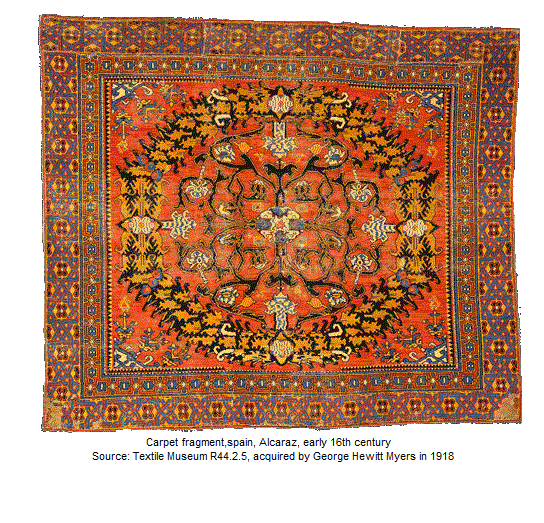The tradition of rug weaving in Spain was developed by the Arab conquerors that are remembered in history as the Moors. Historical records indicate that these Arabs were the ones to teach the people of Spain and Venetia the traditional art of rug weaving. The Spanish rugs that are being sold in the market today as "Moorish Rugs" are actually made according to the techniques and styles popularized by the Arab conquerors of Spain.
Spanish rugs have a distinctively different visual appearance and can be recognized in an instant. Yellow seems to be the predominant color and is found in almost every design made in the country. In terms of their quality and style, they bear close resemblance to another style that is known the "Smyrna rug". Today you will be able to find authentic antique Moorish rugs displayed in mosques and cathedrals in Spain. The cathedrals of Seville and Toledo in particular have a fine collection of Spanish rugs. It is estimated that these rugs date back to the 13th century.

The essence of Spanish rug design was the use geometric patterns. These patterns could range from simple to extremely complex and hence create different kinds of feelings. Each Spanish rug would have been meticulously hand weaved by highly skilled artisans who had been taught the traditional style of rug weaving by the Arabs. Even the dyeing procedure was conducted manually because it produced the rich colors that made the rugs stand out. It is known that when Eleanor, the daughter of Ferdinand III of Castile, came to England to marry Edward I she brought carpets with her. Whether or not these were knotted, or even if they were of Spanish manufacture, is not known, but the records at least set a date when objects called carpets were already in use in Spain. There are still some 15th century pieces to be seen in museums, all of which closely resemble the Turkish carpets of that era. There are more 15 th century Spanish pieces preserved than any other type. By the end of the 15 th century Spain was making carpets herself, even though the work may have been done by immigrants.
Although still showing Turkish treatment in the designs, the carpets also took on various Christian and heraldic devices, until the 17th century when what we regard as a Spanish design had evolved. Because of their background of centuries of Moorish domination, this transposition of design was easier in Spain than perhaps any other country in Europe. The main manufacturing places in the early days were Almeria and Alcaraz. Although isolated instances of carpet production pre-date the Muslim invasion of Spain, the Hispano-Moresque examples are the earliest significant body of European-made carpets. Documentary evidence shows production beginning in Spain as early as the 10th century AD.


The earliest extant Spanish carpet, the so-called Synagogue Carpet is a unique survival dated to the 14th century. Before it was acquired for the museum by its founder Wilhelm Bode in 1880, it allegedly was kept in a Church in Tyrol/Austria. One wonders how it got there. A full account of it has been given by Friedrich Sarre, former director of the Islamic Art Department of the Berlin Museum. The rug is still there and open to visitors in the redecorated exhibition rooms of the Pergamon Museum in Berlin, now hosting the reunited collections of both former Islamic Arts Departments. The design represents a tree, from which rather thin stem branches spring off on either side, terminating in oversized blossoms, each representing a Torah Shrine. The border according to Sarre contains purely decorative Kufic characters meaningless in themselves. Bode refers to the peculiar method of knotting - unlike any other Oriental carpets - discussed in detail in the mentioned article by Sarre & Flemming and which gave rise to the term "Spanish Knot". In the form of the blossoms growing from the branches of the "Tree of Life", Sarre and Flemming perceive a decorative rendering of the Jewish "Ark of the Law": "The Aron-Ha-Kodesch", or holy shrine, which was affixed to the chief wall of the synagogue, and contained the Rolls of the Law, enjoyed from remote antiquity the profoundest veneration. It always has the same form - a rectangular chest with double doors - each with four recessed panels - surmounted by a rectangular gable-end.

The earliest group of Hispano-Moresque carpets, Admiral carpets (also known as armorial carpets), has an all-over geometric, repeat pattern punctuated by blazons of noble, Christian Spanish families. The variety of this design was analyzed most thoroughly by May Beattie. Many of the 15th century, Spanish carpets rely heavily on designs originally developed on the Anatolian Peninsula. Carpet production continued after the Reconquest of Spain and eventual expulsion of the Muslim population in the 15th century. 16th century Renaissance Spanish carpet design is a derivative of silk textile design.

Sources and inspiration: Bérinstain, Valérie, et al. L'art du tapis dans le monde (The art of carpets in the world),. Paris: Mengès, 1996. Print.; Jerrehian Jr., Aram K.A. Oriental Rug Primer. Philadelphia: Running Press, 1980. Print.; Herbert, Janice Summers. Oriental Rugs, New York: Macmillan, 1982. Print.; Hackmack, Adolf. Chinese Carpets and Rugs, Rutland and Tokyo: Tuttle, 1980. Print. ; De Moubray, Amicia, and David Black. Carpets for the home, London: Laurence King Publishing, 1999. Print.; Jacobsen, Charles. Oriental Rugs A Complete Guide, Rutland and Tokyo: Tuttle, 1962. Print.; Bashir, S. (n.d.). Personal interview.; Web site sources and dates of consultation vary (to be confirmed). Without prejudice to official usage.


 Tapis d'Orient Bashir | Bashir Persian Rugs
Tapis d'Orient Bashir | Bashir Persian Rugs
 @tapisbashir
@tapisbashir
 @bashircarpets
@bashircarpets
 @bashircarpets
@bashircarpets